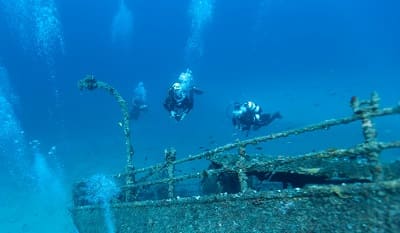Home › A-Z Destinations › Diving in Europe › Croatia
Scuba Diving around Croatia
Divers will find an overwhelming abundance of shipwrecks and reefs scattered around 1,777 kilometres of Adriatic coastline and 1,200 Croatian islands.
This section contains a list of Croatia dive sites for divers and snorkelers to explore with extra details about marine plants and animals found in the Adriatic Sea.
What are the Best Months to Dive in Croatia
The Republic of Croatia is a Mediterranean country located to the north west of the Balkan Peninsula in southern Europe.
As the crow flies, the total distance from north to south of this crescent shaped land mass is only 526 kilometres.
In fact:
This indented section of the Mediterranean enjoys a continental climate that helps to warm the waters of the eastern Adriatic shoreline.
So, which months are the best for scuba diving the Croatian coastline?
In general, the scuba diving season is an annual activity. But, the hot dry months run from June to September and the winter months are the coldest and wettest (January to the end of March).
Pro Tip: The underwater structures at Croatia dive sites means getting the PADI® Wreck Diver certification would qualify you to join organised excursions around sunken shipwrecks in deep water.
Is there Good Diving in Croatia?
It may be cliché, but exploring the underwater caverns, canyons, pillars, wrecks, and reef formations is the reason why divers come here.
There are simply too many top wrecks to list on one page. You can dive around a B-17 bomber and the rusty ruins of WWI and WWII shipwrecks.
But wait - there's more:
Do you enjoy diving in caves and caverns? If so, the Blue Cave at Biševo island in the Dalmatian archipelago is one to add to your bucket list.
The Croatian coastline provides stunning destinations for all scuba diving certification levels - including new divers, freedivers, as well as snorkeling aficionados.
Marine Life in the Adriatic Sea
Despite being a small and somewhat enclosed body of water, the Adriatic Sea provides a home for more than six (6) thousand plant and animal species.
There are around 440 different fish species inhabiting the waters and close to 800 species of snails. Plus, Croatian and international laws are in force to help protect endangered or rare species that inhabit the northernmost arm of the Mediterranean Sea, including:
- Adriatic sturgeon (Acipenser Naccarii)
 Dirty cowry (Erosaria Spurca)
Dirty cowry (Erosaria Spurca)- Gorgonian sea fans
- Green wrasse (Labrus Viridis)
- Loggerhead sea turtle (Caretta caretta)
- Mediterranean slipper lobster (Scyllarides latus)
- Noble pen shell (Pinna Nobilis)
- Ocean sunfish (Mola mola)
- Seahorse
- Sharks (e.g., small-spotted catsharks)
- Spider crab (Maja squinado)
Pro Tip: One of the most protected species of all is the Mediterranean monk seal - which is seeing a diminishing degradation of its typical habitat (e.g. secluded beaches and underwater marine caves).
Popular Dive Sites in Croatia
- Banjol Caves
- Bezdan (The Abyss)
- Hausriff Porto Sole
- Mala Afrika
- MS Maona Austrian Freighter
- Peltastis Wreck
Pro Tip: Further development of this section will include the popular Croatian dive sites found at Istria, Kornati archipelago, Kvarner bay, and Korčula.
Related Information and Help Guides
- Scuba Diving in Cyprus
- Scuba Diving in Ireland
- Scuba Diving in Malta
- Scuba Diving in Spain
- Scuba Diving in the United Kingdom
Getting to Croatia
The first step usually involves an international flight to one of the major airports, such as Dubrovnik (DBV), Split (SPU), or to Zadar (ZAD). Following that, using public buses is one of the easiest, and cheapest, ways to get to the coastal cities.